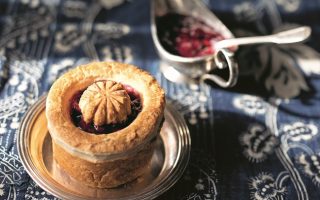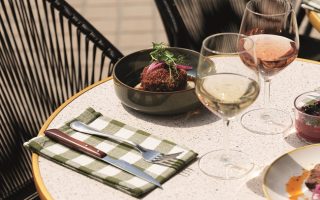In a French Kitchen by Susan Herrmann Loomis
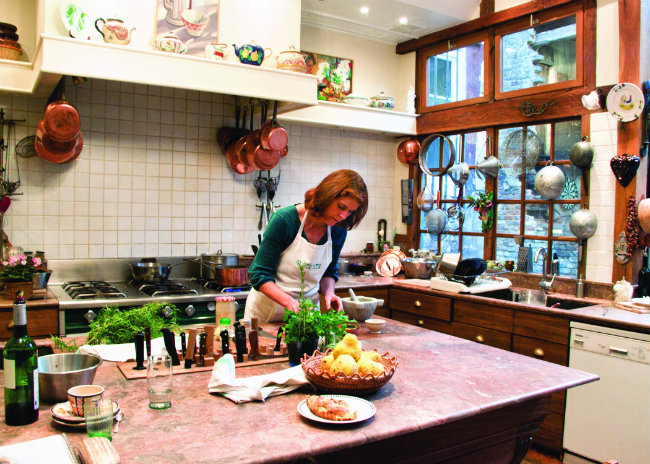
Just before upping sticks from the UK to head across La Manche I read Susan Herrmann Loomis’s On Rue Tatin. If ever we needed the final push to take the plunge into a new life in France this was it – the exciting renovation of an old convent and the description of regional shopping and cooking, written with passion and honesty. So when a copy of Susan’s recent cookery book In a French Kitchen crossed my desk, it didn’t take more than a few pages of reading to be transported back into her world of good French country food, seasoned with the everyday lives of her local friends. In this extract Susan contrasts her dream kitchen with the traditional French setup of a local friend. To further whet your appetites I also asked Susan to choose her three favourite easy-to-cook recipes from the book. Enjoy! — Guy Hibbert, Editor-in-chief
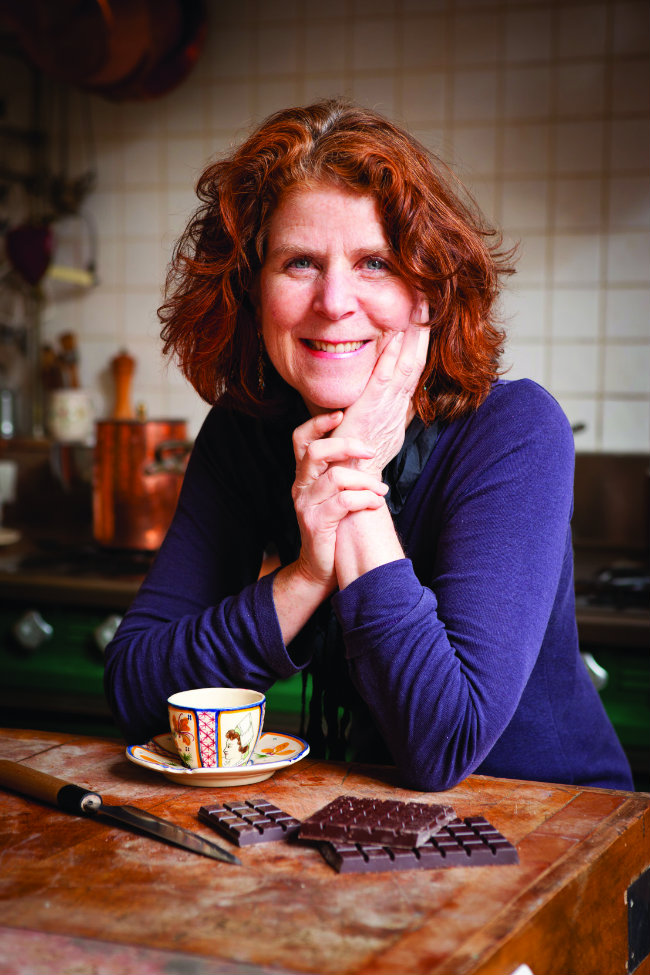
Susan Herrmann Loomis
Our idea of a French Kitchen includes copper pots hanging over a long farm table, lots of counter space, an expansive stove with brass knobs, and a cooking fireplace. There is a nice round table with a crisp tablecloth that gets changed every day, another table off to the side holding a toaster, a bowl full of sugar cubes, a glass with small spoons, and a selection of pretty bowls, all for morning coffee.
Near the stove, there is likely to be a string of garlic hanging somewhere, and there will surely be a basket of shallots and one of onions. Various electrical appliances will be sprinkled about, from a mixer to a juicer to an ice cream maker. Pretty ironed tea towels hang from the stove, and there’s a window topped by a lace valance over the big, stone sink that looks into the courtyard, where a few chickens peck, flowers bloom and herbs thrive.
Off to the side of this dream kitchen and behind a vintage lace curtain is a big, cool, walk-in pantry with a screened window. In there, shelves lined with more vintage lace hold just the basics – a kilo of dried beans, one of rice, one of couscous, perhaps chickpeas, surely stone-green lentils. There is a jar of sugar, several bags of flour, a bag or two of salt, and ample coffee.
There are bottles of oil – olive, peanut, rapeseed – and a vinegar barrel, jars of cornichons and mustard. There are many jars of different kinds of honey, an assortment of homemade jams, a jar or two of chestnut purée. Cheeses wrapped in paper are set under a cloche, or bell, and dried sausages hang from brass nails. The only cans hold tomatoes, tuna and sardines (the latter are turned regularly so they age well). There are crocks of olives, a few jars of tapenade, some of rillettes.
On the floor sits a big crate of potatoes covered by a heavy towel (so they don’t turn green and poisonous), and far from the potatoes, a crate of apples (it is said that apples make potatoes spoil, but this may be folklore).
The refrigerator is small and holds the bare essentials: crème fraîche, unsalted butter, milk, mustard, oranges and lemons, plus smoked salmon. A narrow shelf near the stove holds jars and pots of herbs and spices.
This is the ideal French kitchen, like Monet’s at Giverny in Normandy, where the artist and gourmand did everything right, from the white-and-blue tiles to the mile-long stove to the fireplace. And it’s like my kitchen, which I planned for efficiency and warm comfort.
My own kitchen does resemble Monet’s, in some fashion. But it wasn’t always so. When I bought my house in Normandy, what passed for the kitchen was a dark, triangular room with two big, low windows that looked out on a muddy courtyard. I worked in it that way long enough to realise exactly what I needed to transform it into the warm heart of my home, and an efficient teaching kitchen.
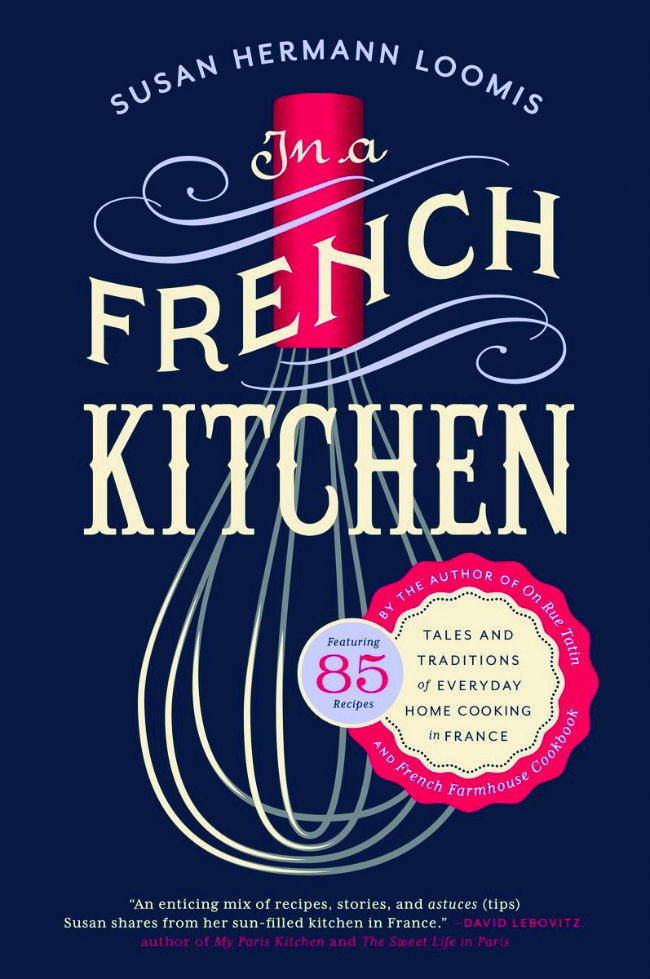
In a French Kitchen by Susan Herrmann Loomis
My list was long – a sturdy, beautiful professional stove, a centre island, lots of light, expansive counter space, several sinks, cupboards for everything from baking pans to the millions of tiny dishes I use for mise en place, organising recipes. I needed a big refrigerator that I could see into, and a fireplace for grilling; and I wanted my utensils at hand, so I could grab them fast. I got it all. My six-burner and two-oven stove, hand-built by Cometto, a small company in Burgundy, has gotten hours of use every day over the past 12 years, and it looks brand-new. The island is a 200-year-old butche’s block with huge drawers in it. The large, boxy refrigerator, built in the 1920s, once lived on a farm, and what sold me on it was when the farmer opened the door and said, “You can hang half a sheep in here”. It’s all wood and tile inside and works like a dream. A section of the kitchen is all glass, which pulls in the exterior light. The floor where I work is wood, because wood is easy on the legs, and when you drop something on it, it doesn’t break. The rest of the kitchen has a tile floor, which is beautifully aesthetic, but, as the French would say, bienvenue les dégâts, “welcome the damage”, the minute something falls on it.
I hung copper pots above the stove at easy reach, and a few hidden but open shelves that face the stove – under the central island – give me instant access to pots and pans, while all my other equipment and accessories are in roomy drawers. I have a coffee sink, a vegetable washing sink, and a dishwashing sink. Above the coffee sink is my fanciful array of vintage coffee bowls that I buy when I find them at foires à tout, town-wide garage sales, frilly teacups from my grandmother’s collection, and a collection of espresso cups that I’ve picked up here and there.
Candles and Copper
I love the space and light in my kitchen; my copper, which I polish after each use (much easier and more efficient than it sounds); my pretty mix of contemporary and antique accessories, which includes a wrought-iron candle holder attached to one of the wooden beams near the sink, which sheds a warm glow after I’ve climbed up on the kitchen counter to light the four candles in it; my multiple sinks and custom-made cupboards. I love the big butcher block, the cracks which I fill with melted beeswax when they start to open up; I love my trash drawers under each sink.
Efficiency is vital to both my mind and my work, and to that end I have a dishwasher that does a quiet load in 17 minutes, and my tongs, peelers, mixing blades, and other indispensable miscellany hang on either side of the stove for easy reach. Peppers and braids of garlic hang on hooks looking beautiful, and sometimes they’re joined by air-cured sausages, too. My baking sheets have their own tall, narrow drawer; I have a woodstove and a fireplace in the kitchen, each of which serves a specific purpose. The woodstove provides heat and acts as a plate warmer; the fireplace is my barbecue.
It’s all so pleasing to my eye, and so efficient and comfortable to work in, and it’s been put together with such care, using artefacts and treasures that I’ve found all around me. Of course it’s a French kitchen. But then, I’m American in a French land, so it’s really my romantic version of a French kitchen. And since I love to not waste time or movement, it is efficiently designed and very well equipped. My French friends? They just want to get great food on the table.
In a French Kitchen: Tales and Traditions of Everyday Home Cooking in France by Susan Herrmann Loomis is published by Avery, an imprint of Penguin Random House.
RECIPES
MATAFAN, 4 to 6 main course servings
The name means, literally, “hunger beater” and this dish resembles Yorkshire pudding, or a savoury Dutch baby. Originally from the Savoie, it was served to field hands in the afternoon, to keep them going until late in the evening. Some say it originally included apples, and was seasoned with sugar and cinnamon. Others insist it had a hint of walnut oil in it, along with onion tops. I like this version, which I got from my friend Fabienne’s mother, who used to make it for her family. It’s a great mid-week supper, served as here with bacon and chives, or with apples and walnut oil. While the matafan was traditionally fried, this one is browned and baked, leaving time to prepare the rest of the meal. While it strays from tradition, it results in a lovely light and savoury bread/cake that is perfect with a green salad.
Ingredients
4 ounces (120g) lightly smoked bacon, cut in large dice
1-1/3 cups (200g) all-purpose flour
3 large eggs
2 cups (500ml) milk
1 pinch fine sea salt
1 small bunch of chives, or the green parts of 4 scallions
3 tablespoons (45g) unsalted butter
2 ounces (60g) Gruyère, grated
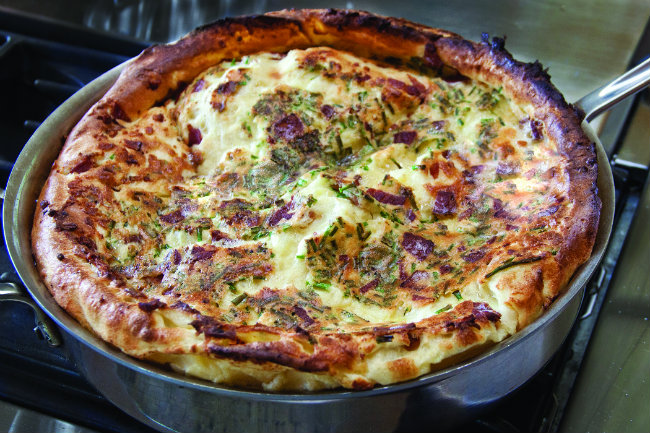
Matafan. Photo: In a French Kitchen
1. Preheat the oven to 425ºF (220ºC).
2. Place the bacon in a small, heavy skillet over medium heat and cook, stirring often, until it is golden at the edges. Remove from the heat.
3. Place the flour in a large bowl, and make a well in the centre. Break the eggs into the well, then add 1 cup (250ml) milk and a large pinch of salt. Whisk together the eggs and the milk, then gradually whisk in the flour until all is blended. Slowly whisk in the remaining milk. The batter should be quite liquid and make a thick ribbon when you lift out the whisk.
4. Mince the chives or the scallion tops, and stir them into the batter.
5. Melt the butter in a large, heavy-bottomed skillet. When the butter is hot and foaming, pour the batter into the pan and pull back on the edges of the batter just to make sure that all of the batter is in the butter, and none is sticking to the bottom or sides of the pan. Cook until the batter is golden on the bottom, tipping the pan gently back and forth, for about 4 minutes (lift the edge of the matafan to see if it is browning). Sprinkle the bacon over the batter, then place the skillet in the oven until the matafan is puffed and golden, 15 to 20 minutes. Remove the matafan from the oven and sprinkle it with the cheese. Serve immediately.
STEAK WITH MELTED ONIONS, STEAK AUX OIGNONS CONFIT, 4 servings
Try this easy, homey yet elegant French dish, to nourish and impress!
Ingredients
For the onions:
2 tablespoons unsalted butter
1-1/2 pounds (750g) yellow onions, peeled and very thinly sliced
Fine sea salt and freshly ground black pepper
For the steak:
Four 5 to 7 ounce (150-210g) steaks, the cut of your choice, at room temperature
Coarse salt and freshly ground black pepper
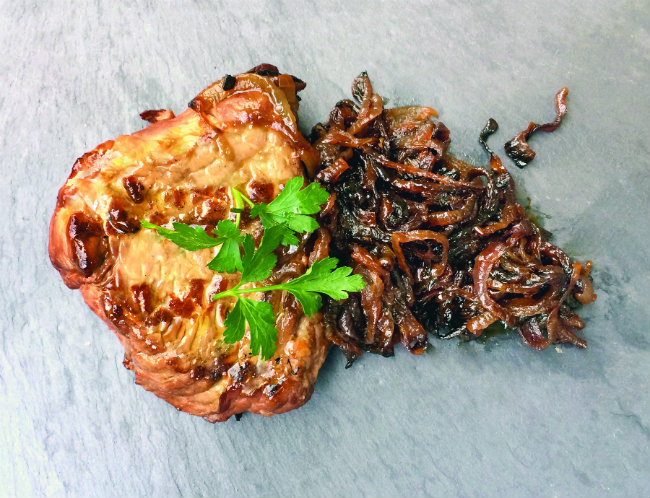
Steak with melted onions. Photo: In a French Kitchen
1. Melt the butter in a large, heavy skillet over medium heat. When the butter is foaming, add the onions, season with salt and pepper, and stir so they are coated with butter. When they begin to sizzle and cook, reduce the heat to low, stir, cover, and cook until they are golden, which will take about 20 minutes, stirring often so they don’t stick. Once they are golden, continue to cook, stirring often, until they are reduced and thick and a quite dark brown colour, an additional 20 minutes. Remove from the heat and reserve.
2. Heat a heavy skillet over medium heat until it is hot enough that a drop of water dances on the surface. Place the steaks in the pan, season with salt, and cook for 2 minutes. Flip the steaks, season with salt and pepper, and cook until the steak is done to your liking. For those who like it rare, another 2 minutes will suffice; for medium, about 4 minutes will do the trick.
3. To serve, transfer each of the steaks to a warmed dinner plate. Top each steak with a mound of onions. Alternatively, place the onions in the centre of four warmed dinner plates, patting them into a thick round, and set the steak atop them. Season with salt and pepper and garnish with the herbs. Serve immediately.
INDIVIDUAL APPLE TARTS WITH TENDER TART PASTRY, TARTES AUX POMMES INDIVIDUELS À LA PÂTE BRISÉE (6 individual tarts)
Apple tart is universal in France, and Bordeaux is no exception. This simple tart, which brings this meal to a close, is made special with a drizzle of honey – it adds a floral hint to the apples, an added dimension.
Ingredients
On Rue Tatin’s Tender Tart Pastry (see recipe below)
3 medium (about 5.5 oz; 165g each) apples, such as Cox Orange Pippins, Reine de Reinette, Jonagold
2 tablespoons (25g) light brown sugar
3 teaspoons mild honey
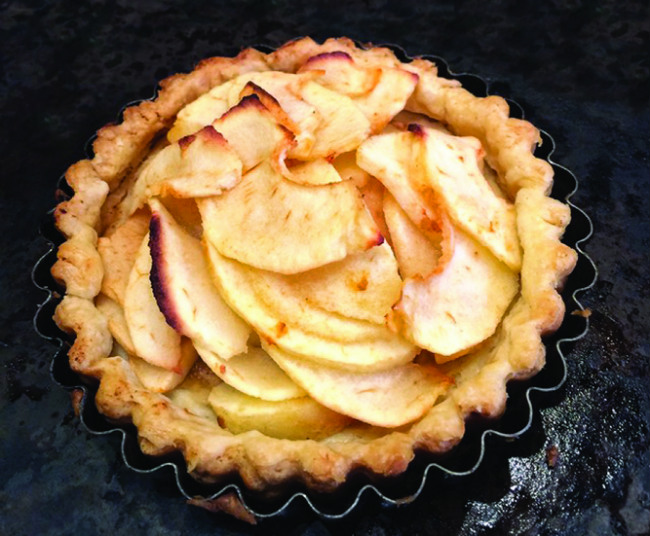
Apple tart. Photo: In a French Kitchen
1. Line two baking sheets with parchment paper.
2. Roll out the pastry as fine as you possibly can. Cut out six 7-inch (17.5cm) rounds, and transfer them to the baking sheets. Refrigerate for at least 30 minutes, and up to several hours. If you plan to refrigerate them for several hours (or overnight), cover them with parchment paper, then aluminium foil so they don’t dry out.
3. Preheat the oven to 450F (230C).
4. Peel, halve, and core the apples. Cut them, crosswise, into paper-thin slices. Remove the pastry rounds from the refrigerator and arrange the slices from one-half an apple on each of the pastry rounds, overlapping the slices slightly, and mounding them attractively in the centre. Sprinkle each tart evenly with 1 teaspoon of brown sugar, then bake in the oven until the pastry is golden, apples are golden at the edges and the sugar has begun to caramelise, 25 to 30 minutes. If you have the baking sheets on two racks, you will need to switch them halfway through cooking so the tarts bake evenly.
5. Remove the tarts from the oven and drizzle the apples of each one with 1/2 teaspoon of the honey. Transfer to a cooling rack and let cool slightly, or to room temperature, before serving.
ON RUE TATIN’S TENDER TART PASTRY, LA PATE TENDRE D’ON RUE TATIN
Pastry for one 10 1/2-inch (26 1/2 cm) to 12-1/2 inch (31.5cm)
Ingredients
1 1/2 cups (225 g) unbleached all-purpose flour
1/4 teaspoon sea salt
12 tablespoons (180 g) unsalted butter, chilled and cut into 12 pieces
5 to 6 tablespoons ice water
1. Place the flour and the salt in a food processor and process once to mix. Add the butter and process until the mixture resembles coarse meal. Add the 5 tablespoons ice water and pulse just until the pastry begins to hold together. If the pastry seems dry and dusty, add the remaining 1 tablespoon of water.
2. Transfer the pastry from the food processor to your work surface and form it into a flat round. Let it rest on a work surface, covered with a bowl, for at least 30 minutes. The pastry can sit several hours at room temperature, as long as the room isn’t warmer than 68 degrees. The pastry is ready to use as desired.
Excerpts published with permission in France Today magazine
Share to: Facebook Twitter LinkedIn Email
Leave a reply
Your email address will not be published. Required fields are marked *


